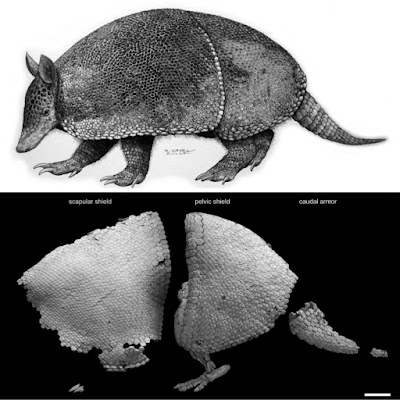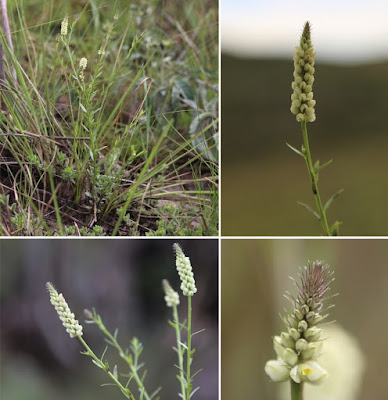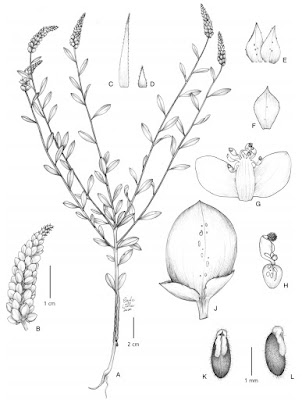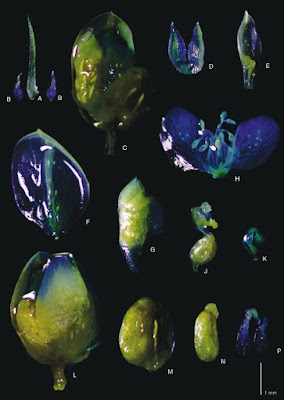[Most Recent Entries] [Calendar View]
Friday, August 31st, 2018
| Time | Event | ||||
| 9:12a | [PaleoMammalogy • 2018] Neoglyptatelus uruguayensis • A New Species of Neoglyptatelus (Xenarthra, Cingulata) from the Late Miocene of Uruguay Provides New Insights on the Evolution of the Dorsal Armor in Cingulates
Abstract The genus Neoglyptatelus Carlini, Vizcaíno and Scillato-Yané has been considered a member of Glyptatelinae, a group encompassing the purportedly basal-most glyptodonts. It is up to now represented by two species from Colombia: Neoglyptatelus originalis Carlini, Vizcaíno and Scillato-Yané, from the middle Miocene (a carapace fragment, isolated osteoderms and postcranial bones), and Neoglyptatelus sincelejanus Villarroel and Clavijo, from the middle or late Miocene (a partial carapace and a caudal armor). More scarce material assigned to this genus was recovered from the late Miocene of Uruguay and Brazil. In this article, we describe a new species, Neoglyptatelus uruguayensis, from the late Miocene Camacho Formation, Uruguay, based on an almost complete carapace and several postcranial bones. We conducted a phylogenetic analysis based on 167 morphological characters (23 new ones and 144 from previous analysis) scored for 19 taxa, encompassing some of the best known glyptodontid genera, one pampathere and four armadillos (including the enigmatic genus Pachyarmatherium Downing and White). In the most parsimonious tree that was obtained, Neoglyptatelus forms a clade with Pachyarmatherium (Pachyarmatheriidae), which is the sister group of the glyptodonts + pampatheres clade; consequently, it is not a glyptodont, as previously believed. This result, together with the known stratigraphic and geographic distribution of Neoglyptatelus and Pachyarmatherium, suggests that this new cingulate clade originated in South America and that Pachyarmatherium reached North America during the Plio—Pleistocene. The carapace of Neoglyptatelus and Pachyarmatherium comprises pelvic and scapular shields overlapping each other without separate intervening transverse mobile bands, an arrangement that differentiates both genera from the remaining cingulates. Keywords: Carapace, Movement, Pachyarmatheriidae, Glyptatelinae, Phylogeny, Caparazón, Movimiento, Pachyarmatheriidae, Glyptatelinae, Filogenia
SYSTEMATIC PALEONTOLOGY Order CINGULATA Illiger, 1811 Family PACHYARMATHERIIDAE new rank Type genus. Pachyarmatherium Downing and White, 1995. Genus NEOGLYPTATELUS Carlini, Vizcaíno, and Scillato-Yané, 1997 Type species. Neoglyptatelus originalis Carlini, Vizcaíno, and ScillatoYané, 1997 Neoglyptatelus uruguayensis sp. nov. Derivation of name. uruguayensis; from Uruguay, to emphasize its geographic provenance. Juan C. Fernicola, Andrés Rinderknecht, Washington Jones, Sergio F. Vizcaíno and Kleberson Porpino. 2018. A New Species of Neoglyptatelus (Mammalia, Xenarthra, Cingulata) from the Late Miocene of Uruguay Provides New Insights on the Evolution of the Dorsal Armor in Cingulates [UNA NUEVA ESPECIE DE NEOGLYPTATELUS (MAMMALIA, XENARTHRA, CINGULATA) DEL MIOCENO TARDÍO DE URUGUAY PROPORCIONA NUEVAS PERSPECTIVAS SOBRE LA EVOLUCIÓN DEL CAPARAZÓN DORSAL EN LOS CINGULADOS]. Ameghiniana. 55(3):233-252. DOI: 10.5710/AMGH.02.12.2017.3150 Resumen: El género Neoglyptatelus Carlini, Vizcaíno and Scillato-Yané ha sido considerado un miembro de los Glyptatelinae, un grupo que supuestamente incluye a los gliptodontes basales. Actualmente, está representado por dos especies halladas en Colombia: Neoglyptatelus originalis Carlini, Vizcaíno and Scillato-Yané, del Mioceno medio (fragmento de caparazón, osteodermos aislados y elementos postcraneanos) y Neoglyptatelus sincelejanus Villarroel y Clavijo del Mioceno medio o tardío (parte de un caparazón y coraza caudal). Osteodermos aislados asignados a este género fueron recuperados en el Mioceno tardío de Uruguay y Brasil. En este trabajo, nosotros describimos una nueva especie, Neoglyptatelus uruguayensis, del Mioceno tardío de la Formación Camacho, Uruguay, a base de una coraza casi completa y distintos elementos postcraneanos. Nuestro estudio filogenético se sustenta en 167 caracteres óseos (23 nuevos y 144 utilizados previamente) relevados en 19 taxones, que incluyen los géneros de gliptodontes mejor conocidos, un pampaterio y cuatro armadillos, incluyendo Pachyarmatherium Downing y White. En el árbol más parsimonioso obtenido Neoglyptatelus forma con Pachyarmatherium un clado (Pachyarmatheriidae) hermano del grupo formado por pampaterios + gliptodontes, por lo cual no es un gliptodonte como se sostenía previamente. Este resultado, junto al conocimiento estratigráfico y geográfico de Neoglyptatelus y Pachyarmatherium, sugiere que los Pachyarmatheriidae se habrían originado en América del Sur y que durante el Plio—Pleistoceno Pachyarmatherium arribó a América del Norte. El caparazón de Neoglyptatelus y Pachyarmatherium contiene un escudo escapular y otro pélvico que solapan directamente entre sí, sin mediar bandas movibles transversas; este arreglo morfológico es único entre los cingulados. | ||||
| 4:17p | [Botany • 2018] Polygala veadeiroensis (Polygalaceae) • A New Species of Polygala endemic to Chapada dos Veadeiros, Goiás, Brazil
Summary A new species, Polygala veadeiroensis (Polygalaceae) subgenus Polygala section Timutua DC. series Timoutoideae, is described from Chapada dos Veadeiros, Goiás State, Brazil. The infrageneric placement and its conservation status are assessed and its habitat and phenology are included. The new species is compared with its morphologically allied species, P. carphoides and P. cuspidata. Illustrations, photos of floral parts under magnification, and a distribution map are also provided. Key Words: endemic species, subgenus Polygala, taxonomy Polygala veadeiroensis J. F. B. Pastore sp. nov. Type: Brazil, Goiás, Chapada dos Veadeiros, Cavalcante, estrada [Rodovia GO-118], entre Cavalcante e Santa Teresina de Goiás, 14°03'27"S 47º30'16"W, 6 March 2003, Pastore & Suganuma 417 (holotype CTBS!; isotype CEN!). recognition: The crested keel places Polygala veadeiroensis within Polygala subgenus Polygala, in addition the spiciform raceme, yellowish spots on floral parts, sepals with acuminate apex, winged stems, and verticillate leaves at proximal nodes are all associated with species belonging to Polygala section Timutua series Timoutoideae Chodat. Polygala veadeiroensis is morphologically most similar to P. carphoides Chodat, from which it is readily separable by its leaves 2.5 – 4 × 1.1 – 1.9 cm, racemes 2 – 3 × 0.8 cm, and linear bracts 2.3 – 2.5 mm long (vs leaves 0.4 – 0.9 × 0.1 – 0.3 cm, racemes 0.5 – 1.5 × 0.35 – 0.5 cm, and lanceolate bracts 0.7 – 1.5 mm long in P. carphoides). On the other hand P. veadeiroensis can be easily recognised by the short bracts when compared with P. cuspidata (2.3 – 2.5 cm vs 4.8 – 9 cm in P. cuspidata).
Distribution: Most of the analysed specimens of Polygala veadeiroensis (except Pastore & Suganuma 648 and Cardoso et al. 2531) are likely to be derived from the same stretch of c. 20 km along the GO-118 road between Alto Paraíso de Goiás and Teresina de Goiás, on the borders of the Chapada dos Veadeiros National Park (CVNP). However, other populations are likely to occur inside the CVNP (Map 1). Habitat: Polygala veadeiroensis occurs in rocky field areas, called campo limpo rupestre, in sandy soil; altitudes between c. 1,200 – 1,500 m. Fig. 3E. Conservation status: Although Polygala veadeiroensis is likely to have a wider occurrence inside the area of CVNP (beyond the area estimated here), using the available data to determine the conservation status suggests the criterion VU (2B: a, b3) of IUCN (2012). The known area of occupancy is estimated to be less than 2,000 km2 (c. 228 km2) and because the only known habitat is quite near the interstate roads GO-118 and GO-239, a continued decline of habitat quality and quantity is anticipated. Etymology: Polygala veadeiroensis refers to the Chapada Veadeiros region in the northeast of the Goiás State in Brazil. J. F. B. Pastore. 2018. Polygala veadeiroensis (Polygalaceae), A New Species of Polygala endemic to Chapada dos Veadeiros, Goiás, Brazil. Kew Bulletin. 73:37. DOI: 10.1007/s12225-018-9759-0 |
| << Previous Day |
2018/08/31 [Calendar] |
Next Day >> |






